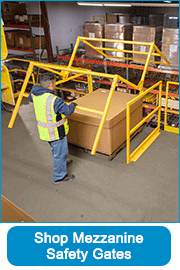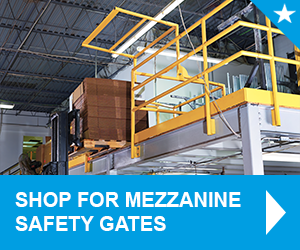
Mezzanines are useful highly useful areas of any industrial facility or warehouse, but they present an added fall hazard. Workers on mezzanines are always at risk of falling, and personnel nearby are exposed to risk from falling tools, debris, and equipment. Good news: facility managers can manage and minimize all these risks by investing in protective equipment like a mezzanine safety gate, railings, and other OSHA-compliant products.
This article will explore OSHA fall protection regulations, especially those concerning mezzanines. We’ll also explain how they apply in industrial settings and highlight the best fall safety devices and best practices for keeping workers safe. Let’s get started.
OSHA Regulations Concerning Mezzanine Fall Protection
OSHA’s fall protection guidelines on mezzanines and other elevated platforms are well defined in this OSHA Fact Sheet. Below are some of the mandates of the mezzanine fall safety regulations:
Duty to Have Fall Protection
Regulations require employers to protect workers from fall risks common along unprotected edges of platforms 4 feet (or more) above the ground. Beyond that, OSHA requires facility managers to oversee the inspection, correct usage, and maintenance of fall protection systems. These may include mezzanine gates, guardrails, harnesses, self-retracting lifelines, access control gates, and more.
Guardrail Fall Protection Criteria
OSHA guidelines on guardrail fall protection criteria dictate that a guardrail safety system’s top edge must be 42(±)3 inches above the floor. What’s more, the guardrail must be capable of withstanding up to 200 pounds of force in a downward or upward direction. Other guardrail fall protection requirements include mid-rail installation, high platform barriers, handrails, and safety gates. Lastly, all guardrail safety systems should be smooth-surfaced.
Covering of Holes in Walking/Working Surfaces
Elevated surface openings in or above mezzanines such as skylights and access points can pose a significant fall risk to employees working or walking on those platforms. OSHA requires employers to provide guardrails (as noted above) or covers to seal the openings. The cover must be capable of withstanding twice as much force as it’s projected to receive. Further, they must be securely fixed so nobody can remove or displace them accidentally.
Immovable Ladder Installation
It’s a routine for workers to carry equipment, raw materials, or finished products to and from elevated surfaces like mezzanines regularly. Employers must provide fixed ladders with a height of at least 24-feet above the lower surface. A ladder safety system consisting of a safety sleeve, carrier, body harness, harness lanyard, ladder cage, and connectors must also be availed. Installing an access control element like an indoor safety gate or ladder guard is also recommended.
Adequate Employee Safety Training
Providing OSHA-compliant mezzanine fall protection systems and devices is just part of employers’ obligations. You must also provide your workforce with a rigorous training program so they can learn to be at the forefront awareness and responsibility for safety. Instilling a safety-first culture through adequate training will ensure both employee and facility safety, improving the safety of your workers and avoiding OSHA penalties.
Falling Object Protection
OSHA regulations also specify that employees working underneath mezzanines and other elevated surfaces be protected from falling objects. Employers must acquire and install fall protection equipment like toeboards (vertical barriers usually mounted at the edge of a surface). They can help provide overhead protection against falling materials. OSHA further directs that the toeboards must have a vertical height of at least 3.5 inches. They should also be capable of withstanding up to 50 pounds of force impacted in a downward or outward direction.
Important Note: Whereas complying with OSHA fall safety regulations is always imperative, you also want to factor in the local building codes, IBC, and ANSI standards when utilizing your industrial facilities or designing the mezzanines. Ensure the size and design of a mezzanine safety gate, for example, meets the set ANSI & IBC bare minimums, not to forget the standard for elevated working surfaces. Non-compliance not only puts employees’ safety at risk but also attracts hefty fines.

When in the market for fall safety devices for elevated grounds, be sure to confirm that they’re OSHA-approved before spending your money. Below is a review of some of the best mezzanine fall protection systems that you should consider.
Pivoting mezzanine gates are OSHA, IBC, and ANSI compliant fall safety devices that protect against surface edges. They’re made of tough carbon steel, and customizable yellow coat finishes for optimal durability. In terms of dimensions, the single pallet measures 64″ W x 42″ H, whereas its double counterpart is 113″ W x 42″ H in size. What’s more, the gates are simple to install; you only need the basic tools.
Clear Height Mezzanine Safety Gates
Provide optimal workforce fall protection with a OSHA-compliant clear height mezzanine safety gate. This important safety system component features a pair of counterbalanced lift gates and usually includes an indoor safety gate to keep employees from falling over edged surfaces. Thanks to the system’s clear height design, it’s easy to load or unload taller pallets without compromising workers’ safety.
Other related mezzanine fall safety devices include;
- Loading dock gates
- Vertical lift gates
- Ledgeguards
- Anchorage connectors
- Harnesses and lanyards
Additional Mezzanine Fall Safety Best Practices
Aside from installing fall protection systems and training employees adequately, facility managers also need to provide/ensure the following to keep the mezzanines overly safe:
- Sufficient lighting. This assists the workforce in walking around the stairs and other parts of the mezzanine comfortably.
- Non-slip flooring. There shouldn’t be any liquid spillages, dust, or holes that may increase the risk of falling. Further, the mezzanine floor should be uniform level without texture variations to prevent tripping.
- Regular inspection. This is necessary to confirm that the safety systems aren’t cracked, broken, worn, loose, or missing parts. The assessment also affirms that the mezzanine’s load capacity isn’t potentially being exceeded.
- Frequent cleaning. As part of maintenance, the mezzanine should undergo thorough cleaning to prevent debris or dust build-up.
Wrap Up
Hopefully, this article has helped you understand how to implement an OSHA-compliant mezzanine safety solution. To recap: ensure the facility has proper gate and railing protections (ideally including indoor safety gate placement), safe use of ladder equipment, no unprotected holes, and falling object protection. Also, the workforce must undergo adequate training and practice awareness of fall protection.
Are you ready to implement the best mezzanine fall protection devices and systems? Fabenco is your trusted manufacturer of safety-optimized products. We create custom-made equipment that matches clients’ unique requirements and at a fair price. Call us at (888) 496-6364 or visit us online to see our wide range of indoor fall safety products.





